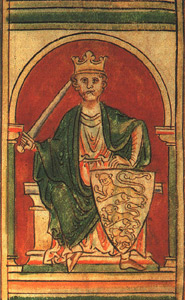
Richard Coer de Lyon is a Middle English romance which gives a fictionalised account of the life of Richard I, King of England, concentrating on his crusading exploits. It influenced Shakespeare's King John and Walter Scott's The Talisman . [1] [2]

Richard Coer de Lyon is a Middle English romance which gives a fictionalised account of the life of Richard I, King of England, concentrating on his crusading exploits. It influenced Shakespeare's King John and Walter Scott's The Talisman . [1] [2]
Richard was written around the beginning of the 14th century, and is based on a lost Anglo-Norman romance dating from c. 1230–1250. The name of the Middle English author is unknown, but he or she is thought to have been from south-east England, and he may also have written the romances Of Arthour and of Merlin and King Alisaunder . [3] [4]
Richard resembles the chansons de geste genre that, like the Song of Roland, describe epic battles between opponents (usually Christian vs. Saracen). [5] As Peter Larkin notes, "Many of the episodes resemble accounts from such crusade chronicles as Ambroise’s Estoire de la guerre sainte and the Itinerarium perigrinorum et gesta regis Ricardi." [6] And, even with the fantastical insertions, the text follows the historical route and many of the events of Richard's crusade. Some of the more fantastical elements, such as Richard's birth narrative, are related to widespread medieval legends. [7] Other episodes parallel those in Richard of Devizes chronicle and Adémar of Chabanne's Chronicon. [8] [9]
Richard Coer de Lyon (‘Richard the Lionheart’) survives in 10 manuscripts, of which the most complete is Cambridge, Gonville and Caius MS 175. [10] The poem was printed in 1509 and 1528, both times by Wynkyn de Worde. An extended abstract of Richard appeared in George Ellis's Specimens of Early English Metrical Romances (1805). The Gonville and Caius manuscript was used by Henry Weber for an edition of the poem included in his Metrical Romances of the Thirteenth, Fourteenth, and Fifteenth Centuries (1810). A 1913 edition of Richard by Karl Brunner used the same manuscript supplemented by Wynkyn de Worde's version. [11] [12] [13] It has also been translated into Modern English by Bradford B. Broughton in his Richard the Lion-Hearted: and Other Medieval English Romances (1966). [14]
Although the Gonville and Caius manuscript is the most complete, i.e., contains the most episodes, there is enormous variety between all of the manuscripts. [15] This has led scholars to recognize that this text was frequently revised and edited over more than 200 years and makes it impossible to declare one text definitive. [16]
A-versions of the romance begin with a fantastical account of Richard's birth. [17] Henry II, in search of a queen, wed Cassodorien, the daughter of the king of Antioch. The pair have three children, Richard, John, and Topyas. They live happily, except Cassodorien always leaves Mass before the elevation of the Host. After Henry forces her to witness it she flies through the church roof, Topyas in tow, and disappears. Richard eventually succeeds Henry II to the throne at the age of 15 on his father's death.
The text then details a tournament in which Richard, in disguise, attempts to determine his best knights. Most impressed by Sir Thomas Multon and Sir Fulk Doyly, who defeat Richard, Richard selects them to join him on a secret mission to the Holy Land. After they visit the Holy Land, they begin the return to England. Their progress is halted when they are imprisoned by the King of Almayn. It is only after Richard kills and eats the heart of a lion that they are all able to return to England.
The rest of the poem details the events of the Third Crusade. After learning of Saladin's attack against Christendom in eastern Europe, the pope calls for aid. Richard, the king of France, the duke of Austria, and the emperor of Almayne respond to his call. After a series of internal struggles with the King of France, the crusaders journey to the holy land, laying siege Cyprus along the way.
Once Richard and the others reach the Holy Land and join the siege of Acre, Richard falls ill. He asks for pork, but there is none. He is revived after being fed a young Saracen. When this cannibalism is revealed to a recovered Richard he laughs and celebrates that his troops won't starve as long as there are Saracens. Revived, Richard leads a victorious assault on Acre. When the Saracens arrive to talk terms, they are served the boiled heads of the Saracen prisoners of war. The Saracens return to their sultan Saladin to report that Richard intends to stay in the Holy Land until the Christians have eaten every Saracen.
A series of battles follow, culminating in two events: Phillip, King of France's betrayal of the Christian forces and Richard's tournament with Saladin. Phillip accepts a bribe from the Saracens to end the siege against Babylon. Saladin subsequently challenges Richard to a tournament. With the help of an angel who informs Richard that Saladin's horse is a demon in disguise, Richard eventually defeats Saladin. Saladin flees.
The poem concludes, after a description of Richard's hearing of John's betrayal and self-appointment as king of England, with an account of a final battle that precedes Saladin's declaring a truce during which time Richard will return to England to secure his lands. The poem then briefly details Richard's death. [18]

Richard I, known as Richard Cœur de Lion or Richard the Lionheart because of his reputation as a great military leader and warrior, was King of England from 1189 until his death in 1199. He also ruled as Duke of Normandy, Aquitaine, and Gascony; Lord of Cyprus; Count of Poitiers, Anjou, Maine, and Nantes; and was overlord of Brittany at various times during the same period. He was the third of five sons of Henry II of England and Eleanor of Aquitaine and was therefore not expected to become king, but his two elder brothers predeceased their father.

Salah ad-Din Yusuf ibn Ayyub, commonly known as Saladin, was the founder of the Ayyubid dynasty. Hailing from a Kurdish family, he was the first sultan of both Egypt and Syria. An important figure of the Third Crusade, he spearheaded the Muslim military effort against the Crusader states in the Levant. At the height of his power, the Ayyubid realm spanned Egypt, Syria, Upper Mesopotamia, the Hejaz, Yemen, and Nubia.

Year 1190 (MCXC) was a common year starting on Monday of the Julian calendar.

The Third Crusade (1189–1192) was an attempt led by three European monarchs of Western Christianity to reconquer the Holy Land following the capture of Jerusalem by the Ayyubid sultan Saladin in 1187. For this reason, the Third Crusade is also known as the Kings' Crusade.

The Battle of Arsuf took place on 7 September 1191, as part of the Third Crusade. It saw a multi-national force of Crusaders, led by Richard I of England, defeat a significantly larger army of the Ayyubid Sultanate, led by Saladin.

Kingdom of Heaven is a 2005 epic historical drama film directed and produced by Ridley Scott and written by William Monahan. It features an ensemble cast including Orlando Bloom, Eva Green, Jeremy Irons, David Thewlis, Brendan Gleeson, Marton Csokas, and Liam Neeson.
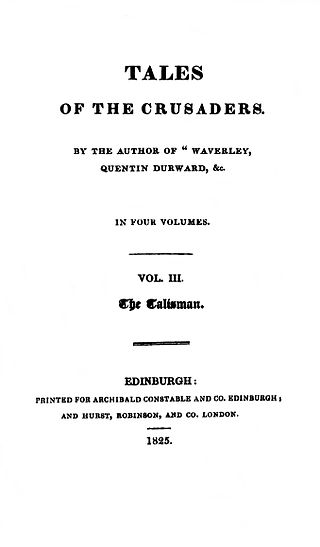
The Talisman is one of the Waverley novels by Sir Walter Scott. Published in 1825 as the second of his Tales of the Crusaders, it is set during the Third Crusade and centres on the relationship between Richard I of England and Saladin.

Medieval French literature is, for the purpose of this article, Medieval literature written in Oïl languages during the period from the eleventh century to the end of the fifteenth century.
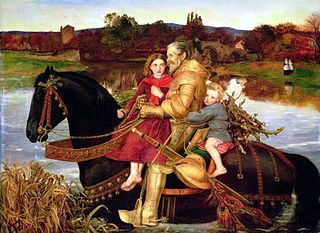
Sir Isumbras is a medieval metrical romance written in Middle English and found in no fewer than nine manuscripts dating to the fifteenth century. This popular romance must have been circulating in England before 1320, because William of Nassyngton, in his work Speculum Vitae, which dates from this time, mentions feats of arms and other 'vanities', such as those found in stories of Sir Guy of Warwick, Bevis of Hampton, Octavian and Sir Isumbras. Unlike the other three stories, the Middle English Sir Isumbras is not a translation of an Old French original.

The Crusades is a 1935 American historical adventure drama film directed and produced by Cecil B. DeMille for Paramount Pictures, loosely based on the life of King Richard I of England during the Third Crusade, and his marriage to Berengaria of Navarre. The film stars Henry Wilcoxon as Richard, Loretta Young as Berengaria, and Ian Keith as Saladin, along with C. Aubrey Smith, Katherine DeMille, Joseph Schildkraut and Alan Hale Sr. in supporting roles.

The Massacre of Ayyadieh occurred during the Third Crusade after the fall of Acre when King Richard I had more than two thousand Muslim prisoners of war from the captured city beheaded in front of the Ayyubid armies of sultan Saladin on 20 August 1191. Despite attacks by Muslim forces during the killings, the Christian Crusaders were able to retire in good order. Saladin subsequently ordered various Crusader prisoners of war to be executed in retaliation.
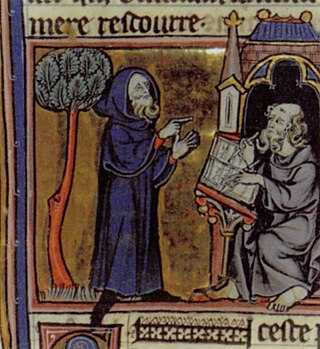
Merlin is a partly lost French epic poem written by Robert de Boron in Old French and dating from either the end of the 12th or beginning of the 13th century. The author reworked Geoffrey of Monmouth's material on the legendary Merlin, emphasising Merlin's power to prophesy and linking him to the Holy Grail. The poem tells of his origin and early life as a redeemed Antichrist, his role in the birth of Arthur, and how Arthur became King of Britain. Merlin's story relates to Robert's two other reputed Grail poems, Joseph d'Arimathie and Perceval. Its motifs became popular in medieval and later Arthuriana, notably the introduction of the sword in the stone, the redefinition of the Grail, and turning the previously peripheral Merlin into a key character in the legend of King Arthur.
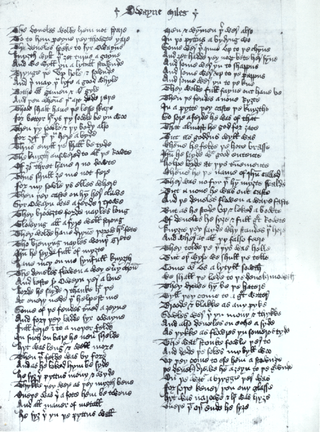
Octavian is a 14th-century Middle English verse translation and abridgement of a mid-13th century Old French romance of the same name. This Middle English version exists in three manuscript copies and in two separate compositions, one of which may have been written by the 14th-century poet Thomas Chestre who also composed Libeaus Desconus and Sir Launfal. The other two copies are not by Chestre and preserve a version of the poem in regular twelve-line tail rhyme stanzas, a verse structure that was popular in the 14th century in England. Both poetic compositions condense the Old French romance to about 1800 lines, a third of its original length, and relate “incidents and motifs common in legend, romance and chanson de geste.” The story describes a trauma that unfolds in the household of Octavian, later the Roman Emperor Augustus, whose own mother deceives him into sending his wife and his two newborn sons into exile and likely death. After many adventures, the family are at last reunited and the guilty mother is appropriately punished.
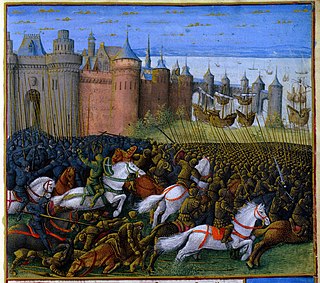
The siege of Tyre took place from 12 November 1187 to 1 January 1188. An army commanded by Saladin made an amphibious assault on the city, defended by Conrad of Montferrat. After two months of continuous struggle, Saladin dismissed his army and retreated to Acre.
The King of Tars is a medieval English chivalric romance, an amplified version of the oldest variant found in the Reimchronik, which is found in three manuscripts including the Auchinleck manuscript. It dates from c. 1330, or perhaps earlier. It contains many specific religious phrases, and is consistently religious in intent. In addition, The King of Tars exhibits attributes of other genres typical of the medieval period, including hagiography, political drama, and miracle tale.

Athelston is an anonymous Middle English verse romance in 812 lines, dating from the mid or late 14th century. Modern scholars often classify it as a "Matter of England" romance, because it deals entirely with pre-Conquest English settings and characters. It is mainly written in twelve-line stanzas rhyming AABCCBDDBEEB, though the poet occasionally varies his meter with stanzas of eight, six, or four lines. The poem survives in only one manuscript, the early 15th-century Gonville and Caius MS 175, which also includes the romances Richard Coer de Lyon, Sir Isumbras and Beves of Hamtoun. It has no title there. Athelston was first printed in 1829, when C. H. Hartshorne included it in his Ancient Metrical Tales.

Beves of Hamtoun, also known as Beves of Hampton, Bevis of Hampton or Sir Beues of Hamtoun, is an anonymous Middle English romance of 4620 lines, dating from around the year 1300, which relates the adventures of the English hero Beves in his own country and in the Near East. It is often classified as a Matter of England romance. It is a paraphrase or loose translation of the Anglo-Norman romance Boeuve de Haumton, and belongs to a large family of romances in many languages, including Welsh, Russian and even Yiddish versions, all dealing with the same hero.

King Alisaunder or Kyng Alisaunder is a Middle English romance or romantic epic in about 4,000 octosyllabic couplets. It tells the story of Alexander the Great's career from his youth, through his successful campaigns against the Persian king Darius and other adversaries, his discovery of the wonders of the East, and his untimely death. George Saintsbury described King Alisaunder as "one of the most spirited of the romances", and W. R. J. Barron wrote of its "shrewd mixture of entertainment and edification made appetizing by literary and stylistic devices of unexpected subtlety."

The Libellus de expugnatione Terrae Sanctae per Saladinum, also called the Chronicon Terrae Sanctae, is a short anonymous Latin account of the conquests of Saladin in the Holy Land between 1186 and 1191. The core of the text was written shortly after the events it describes and then supplemented by the addition of an account of the Third Crusade early in the thirteenth century. This probably took place at Coggeshall Abbey in England. Neither the original author nor the continuator/compiler is known by name.
Of Arthour and of Merlin, also known as just Arthur and Merlin, is an anonymous Middle English verse romance giving an account of the reigns of Vortigern and Uther Pendragon and the early years of King Arthur's reign, in which the magician Merlin plays a large part. It can claim to be the earliest English Arthurian romance. It exists in two recensions: the first, of nearly 10,000 lines, dates from the second half of the 13th century, and the much-abridged second recension, of about 2000 lines, from the 15th century. The first recension breaks off somewhat inconclusively, and many scholars believe this romance was never completed. Arthur and Merlin's main source is the Estoire de Merlin, a French prose romance.